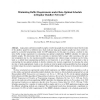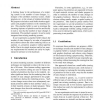60 search results - page 3 / 12 » Reducing memory requirements of stream programs by graph tra... |
VLSISP
2002
13 years 5 months ago
2002
Large-grain synchronous dataflow graphs or multi-rate graphs have the distinct feature that the nodes of the dataflow graph fire at different rates. Such multi-rate large-grain dat...
SEFM
2008
IEEE
14 years 4 days ago
2008
IEEE
We present an approach to find upper bounds of heap space for Java Card applets. Our method first transforms an input bytecode stream into a control flow graph (CFG), and then ...
VMV
2004
13 years 7 months ago
2004
A limiting factor in the performance of a rendering system is the number of state changes, i.e., changes of the attributes material, texture, shader program, etc., in the stream o...
CODES
2000
IEEE
13 years 10 months ago
2000
IEEE
Memory interleaving is a cost-efficient approach to increase bandwidth. Improving data access locality and reducing memory access conflicts are two important aspects to achieve hi...
PPOPP
2009
ACM
14 years 6 months ago
2009
ACM
Due to power wall, memory wall, and ILP wall, we are facing the end of ever increasing single-threaded performance. For this reason, multicore and manycore processors are arising ...


